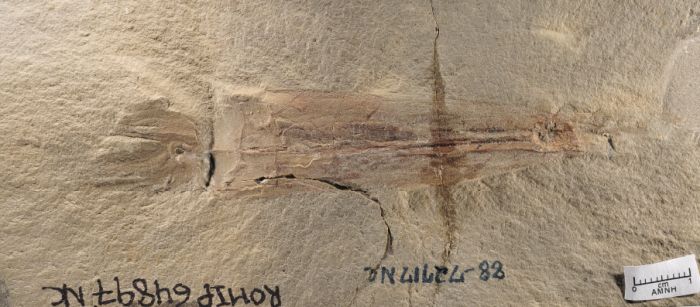An exceptional fossil unearthed in Montana has given us the earliest known ancestor of vampire squids and octopuses.
The cephalopod, belonging to the vampyropod or octopodiform superorder, pushes back the age of the group by about 82 million years.
This challenges our understanding that octopuses evolved from a Triassic ancestor. Fascinatingly, it has not eight, but 10 arms, showing that, somewhere in that time, these animals have lost two working tentacles.
“This is the first and only known vampyropod to possess 10 functional appendages,” says paleontologist Christopher Whalen of the American Museum of Natural History (AMNH) and Yale University.
The newly discovered beastie has been named Syllipsimopodi bideni, in honor of President Joseph Biden, who at the time of the discovery was newly inaugurated with plans to combat climate change (although it does sound like they’re calling him an old vampire with too many arms).
Our understanding of vampyropod evolutionary history is patchy at best. Octopuses and vampire squids – so named for their oft blood-red color, and cloak-like webbing – are soft and squishy creatures with no bones, only an internal shell of chitin, and such tissues do not often survive the ages the way teeth and bones do.
However, in some types of exceptional fossil formations, known as Lagerstättes, soft tissue is occasionally preserved.
This is where Whalen and his coauthor, AMNH paleontologist Neil Landman, found Syllipsimopodi: in fossil recovered from a Lagerstätte in Montana, known as Bear Gulch.
That small impression of a soft body, preserved untouched for hundreds of millions of years, shows that the history of today’s animals was a complex and fascinating saga.
 The Syllipsimopodi fossil, in the Royal Ontario Museum. (Christopher Whalen)
The Syllipsimopodi fossil, in the Royal Ontario Museum. (Christopher Whalen)
“Our findings suggest that the earliest vampyropods, at least superficially, resembled squids that are living today,” Whalen says.
“Syllipsimopodi bideni also challenges the predominant arguments for vampyropod origins and offers a new model for the evolution of internally-shelled cephalopods.”
There had been hints that vampyropod lineages may have been older than the previous oldest known specimen, dated to around 240 million years ago.
The molecular clock of the lineage – the mutation rate of biomolecules in DNA, which can be used to determine the evolutionary history of an organism – suggested that vampyropods originated sometime between 350-330 million years ago.
Whalen and Landman’s discovery corroborates these estimates, further adding that 10-armed Syllipsimopodi is the earliest known diverging vampyropod from the group’s common ancestor. These 10 arms, all with suckers, suggest that this common ancestor also had 10 arms.
“The arm count is one of the defining characteristics separating the 10-armed squid and cuttlefish line (Decabrachia) from the eight armed octopus and vampire squid line (Vampyropoda),” Whalen explains.
“We have long understood that octopuses achieve the eight arm count through elimination of the two filaments of vampire squid, and that these filaments are vestigial arms.
“However, all previously reported fossil vampyropods preserving the appendages only have eight arms, so this fossil is arguably the first confirmation of the idea that all cephalopods ancestrally possessed 10 arms.”
Based on the incredible fossil, the researchers were able to determine that two of Syllipsimopodi‘s arms were longer than the others; it’s possible that these were used to capture prey, while the shorter ones could have been used to hold and manipulate it.
The animal’s body was also torpedo-shaped, like modern squids, and it had fins that seem like they would have been big enough to help Syllipsimopodi swim and stabilize.
In another anatomical similarity to squids (as well as vampire squids), the Syllipsimopodi fossil showed evidence of an internal shell structure called a gladius. Octopuses don’t have this structure; it’s been reduced to bar-shaped structures called stylets.
These characteristics have helped the researchers determine where Syllipsimopodi may have fit into its ecosystems.
“Syllipsimopodi may have filled a niche more similar to extant squids, a midlevel aquatic predator,” Landman says.
“It is not inconceivable that it might have used its sucker-laden arms to pry small ammonoids out of their shells or ventured more inshore to prey on brachiopods, bivalves, or other shelled marine animals.”
The research has been published in Nature Communications.
